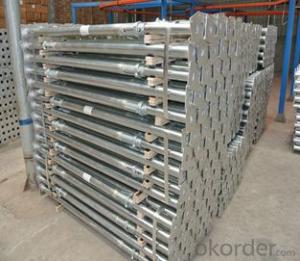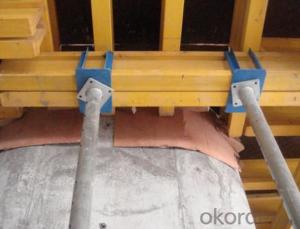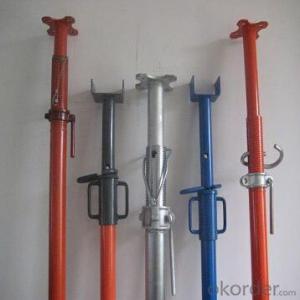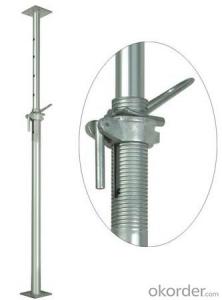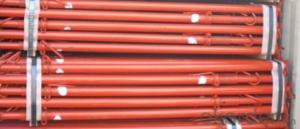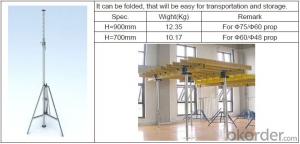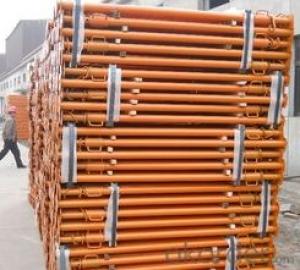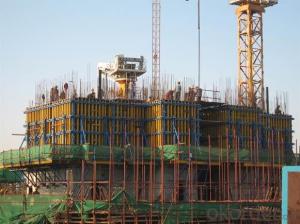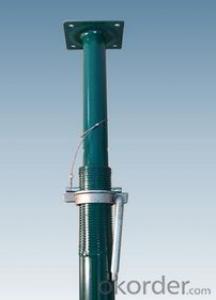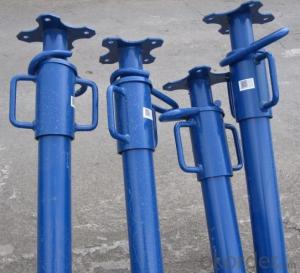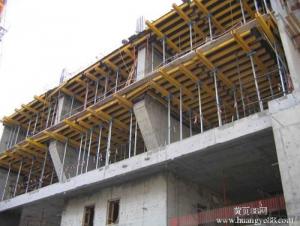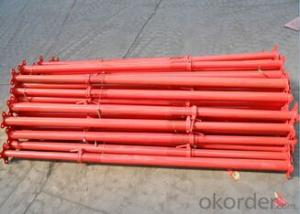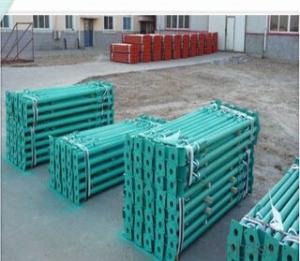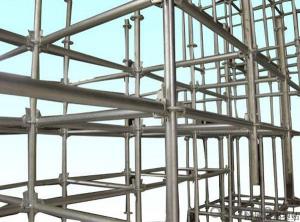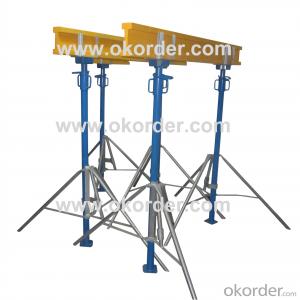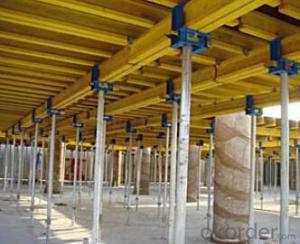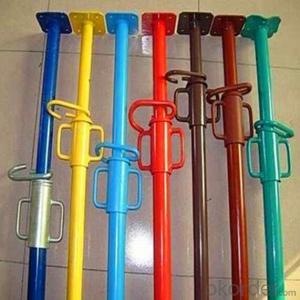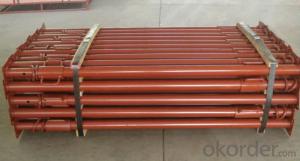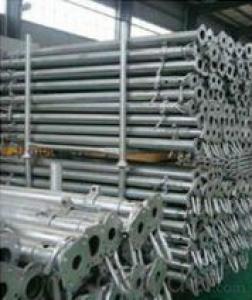Q345 Q235 Adjustable scaffolding steel props
- Loading Port:
- China Main Port
- Payment Terms:
- TT OR LC
- Min Order Qty:
- -
- Supply Capability:
- -
OKorder Service Pledge
Quality Product, Order Online Tracking, Timely Delivery
OKorder Financial Service
Credit Rating, Credit Services, Credit Purchasing
You Might Also Like
Quick Details
| Brand Name: | Model Number: | ||||
| Type: | Scaffolding Part Type: | scaffolding steel props: | |||
| scaffolding props: | Galvanzed steel scaffold props: | scaffold jack props: | |||
| used steel props: | adjustable props: | construction steel props: | |||
| building material: | EN Standard: | Color: |
Packaging & Delivery
| Packaging Detail: | 1. Q345 Adjustable scaffolding steel props 2. in bundles, 50sets/bundle or as per customer's requirement |
| Delivery Detail: | 7~15 days |
Specifications
1.Q345 Adjustable scaffolding shoring props
2.Material: Q235,Q345, S235 Carbon Steel
3.Tube:48mm,56mm, 60mm
Product Description
Product detail:
1. Q345 Adjustable scaffolding shoring props
2.Material: Q235,Q345, S235 Carbon Steel
3.Tube:48mm,56mm, 60mm
4.Wall thickness: 1.6mm, 1.8mm,
5.Finish: painted, powder painted, electro galvanized, hot dipped galvanized
6.scaffolding steel shoring prop
7.Heavy duty and light duty steel shoring prop
8.Bearing capacity: 10~30KN
9.Size: custom design or our regular sizes
- Q: What are the main considerations when using steel props in confined spaces?
- When working with steel props in confined spaces, it is important to take into account several key factors. The first and foremost consideration should always be safety. Confined spaces present various hazards, such as limited ventilation, poor visibility, and the potential for collapse or entrapment. Therefore, it is crucial to ensure the proper and secure placement of steel props, as well as the adherence to all safety precautions. Another significant factor to consider is the size and weight of the steel props. In confined spaces, there may be limited room to maneuver and set up the props. Therefore, it is essential to choose compact and lightweight props that can be easily transported and positioned within the confined area. Furthermore, the height and load-bearing capacity of the steel props must be carefully evaluated. Confined spaces often have specific requirements and restrictions, such as low ceilings or delicate surfaces. It is essential to select props that can safely support the intended load without causing any damage to the surrounding environment. Moreover, the adjustability and versatility of the steel props should be taken into account. Confined spaces may have uneven or irregular surfaces, which necessitate props that can be easily adjusted to provide stable and level support. Additionally, props with adjustable heights can be beneficial in accommodating various space constraints and requirements. Lastly, it is imperative to comply with any relevant regulations and guidelines when using steel props in confined spaces. This may include obtaining necessary permits, conducting thorough risk assessments, and following specific procedures for working in confined spaces. By adhering to these regulations, the safety and well-being of all personnel involved can be ensured. In conclusion, the main considerations when using steel props in confined spaces include safety, size and weight, height and load-bearing capacity, adjustability and versatility, and compliance with regulations. By carefully considering these factors, one can effectively and safely utilize steel props in confined spaces.
- Q: What are the common maintenance and inspection requirements for steel props?
- To ensure the safe and efficient use of steel props, it is important to regularly check and repair them. The following are key maintenance and inspection tasks for steel props: 1. Clean the steel props regularly to remove dirt, debris, and other materials that may affect their performance. You can use a soft brush or cloth and mild detergent if needed. 2. Before and after each use, visually inspect the props to identify any signs of damage or wear. Look for cracks, dents, bends, or any structural issues that may compromise their integrity. 3. Check the load capacity markings to verify if the props are suitable for the intended load. Ensure that they are not overloaded, as this can cause failure or collapse. 4. If the props are adjustable, inspect the mechanisms used for height adjustment. Make sure they function properly, lock securely, and operate smoothly. Lubricate moving parts as necessary. 5. Examine the prop heads, which come into direct contact with the supported structure. Look for signs of wear or damage, such as excessive rust, missing or damaged pins, or loose parts. Promptly replace or repair damaged components. 6. Steel props are prone to corrosion, especially in moist or harsh environments. Follow the manufacturer's recommendations and apply anti-corrosion coatings or paints to protect the props and extend their lifespan. 7. Store the steel props in a clean and dry area, away from direct sunlight and extreme temperatures. Keep them organized to prevent accidental impact or damage. 8. Regularly have a competent person conduct inspections to ensure compliance with safety regulations and identify potential issues. This can be done annually or as recommended by the manufacturer or relevant standards. 9. Keep proper documentation of inspections, repairs, and maintenance activities performed on the steel props. This helps track their condition over time and identify any recurring issues or safety concerns. 10. Ensure that operators and users are trained in the correct use, inspection, and maintenance of steel props. Provide clear instructions and guidelines for safe handling, assembly, and dismantling procedures. By following these maintenance and inspection requirements, users can ensure the safety and longevity of steel props, reducing the risk of accidents and maximizing their performance.
- Q: How do you ensure the stability of steel props on soft or unstable ground?
- To ensure the stability of steel props on soft or unstable ground, there are several measures that one can consider: 1. Enlarging the base plate: By increasing the size of the base plate that supports the steel props, the weight can be spread over a larger area. This helps to reduce the pressure exerted on the soft or unstable ground, effectively preventing sinking or instability. 2. Adding extra support: In cases where the ground is particularly soft or unstable, additional measures like using timber sleepers or steel plates underneath the base plate can provide additional support and stability. These materials aid in distributing the load evenly, preventing sinking or tilting. 3. Installing ground anchors: Ground anchors can be utilized to secure the steel props and prevent any shifting or sinking. Typically installed at an angle and attached to the steel props, these anchors offer additional stability by anchoring the props to more stable layers of soil or rock beneath the surface. 4. Considering adjustable props: Adjustable steel props can be advantageous when dealing with soft or unstable ground. They allow for easy and precise height adjustments, ensuring that the desired stability and height are maintained. Regular monitoring and adjustment of these props can promptly address any potential issues. 5. Seeking professional advice: When uncertain about the ground's stability or the appropriate measures to take, it is advisable to consult with a professional engineer or structural expert. They can assess the specific site conditions and provide expert guidance on the most suitable methods to ensure stability and mitigate potential hazards.
- Q: Are steel props suitable for supporting temporary recreational facilities?
- Yes, steel props are suitable for supporting temporary recreational facilities. Steel props provide strong and stable support, making them ideal for ensuring the safety and stability of temporary structures such as recreational facilities.
- Q: Are steel props suitable for supporting temporary military or defense structures?
- Yes, steel props are suitable for supporting temporary military or defense structures. Steel props provide strong and reliable support, making them ideal for ensuring the stability and durability of such structures in challenging and unpredictable environments. Additionally, steel props can be easily adjusted and modified to accommodate different sizes and weights, making them versatile and practical for military and defense purposes.
- Q: How do steel props compare to hydraulic shores in terms of safety?
- Steel props and hydraulic shores are both commonly used in construction to provide temporary support to structures. In terms of safety, both options have their advantages and considerations. Steel props are typically more rigid and can handle heavier loads, offering stability and reliability. However, they require manual adjustment and might not be as adaptable to uneven surfaces. On the other hand, hydraulic shores offer the advantage of adjustable height and easy installation, making them suitable for quick and efficient support. Nevertheless, their reliance on hydraulic pressure introduces the risk of leaks or sudden failure. Ultimately, the choice between steel props and hydraulic shores should be based on the specific project requirements and a thorough assessment of safety considerations.
- Q: How long does a steel prop typically last?
- A steel prop typically lasts for several years, depending on the frequency of use, the load it supports, and the maintenance provided.
- Q: How do steel props contribute to the stability of a structure?
- Steel props, also known as temporary support systems, play a crucial role in ensuring the stability of a structure during construction or renovation. These adjustable steel columns are typically used to provide temporary support to beams, slabs, walls, and other structural elements. Firstly, steel props help distribute the weight of the structure evenly by transferring the load from the upper levels to the foundation. This balanced weight distribution prevents excessive stress on any particular area, reducing the risk of structural failure or collapse. Furthermore, steel props provide vertical support, preventing sagging or deflection of beams and slabs. This is particularly important during construction when fresh concrete is poured and needs to cure properly. The props ensure that the weight of the wet concrete is evenly distributed, preventing any deformation or cracking that could compromise the overall stability of the structure. In addition, steel props contribute to the stability of a structure by providing lateral support. They help resist horizontal forces, such as wind or earthquakes, by bracing the walls or columns. This prevents excessive swaying or shifting of the structure, reducing the risk of damage or collapse in case of external forces. Moreover, steel props are adjustable, allowing for fine-tuning and precise leveling of the structure. This adjustability is essential when dealing with uneven ground or when aligning different structural components. By providing accurate vertical alignment, steel props ensure that the structure is stable and plumb. Overall, steel props are indispensable for maintaining the stability of a structure during construction or renovation. They evenly distribute the weight, provide vertical and lateral support, and allow for precise leveling. By utilizing steel props, construction projects can proceed safely, ensuring the structural integrity of the building.
- Q: Are steel props suitable for use in tunnel ventilation system installation?
- Yes, steel props are suitable for use in tunnel ventilation system installations. Steel props are commonly used to support tunnel walls and ceilings during construction and maintenance activities. They are strong, durable, and have the ability to withstand heavy loads, making them ideal for providing stability and support in tunnel ventilation systems. Additionally, steel props can be easily adjusted and secured in place, allowing for flexibility in positioning the ventilation equipment and ensuring proper airflow in the tunnel. Overall, steel props are a reliable and practical choice for use in tunnel ventilation system installations.
- Q: Are steel props suitable for use in temporary shoring?
- Temporary shoring can utilize steel props, also referred to as adjustable steel props or steel shore props. These props are commonly employed in construction to provide temporary support while formwork and scaffolding are being erected. Steel props have numerous advantages that render them suitable for temporary shoring. Firstly, their durability allows them to withstand heavy loads, making them ideal for supporting concrete slabs, beams, and other structural elements. Their sturdy construction ensures stability and eliminates the risk of collapse or failure. Furthermore, the adjustability of steel props enables precise height adjustments to meet various shoring requirements. This feature makes them versatile and appropriate for different construction applications. Typically, props are equipped with a threaded screw mechanism or a hydraulic system, simplifying adjustment and ensuring secure positioning. Moreover, steel props are cost-effective and reusable. They can be easily disassembled, transported, and reused in multiple construction projects, reducing the need for frequent purchases and minimizing waste. This practicality makes them an excellent choice for temporary shoring, providing long-term cost savings. In conclusion, steel props are indeed suitable for temporary shoring. Their durability, adjustability, and cost-effectiveness make them an excellent option for providing temporary support during construction projects. However, it is essential to ensure that steel props are designed, installed, and maintained according to industry standards and guidelines to guarantee their safe and effective use.
Send your message to us
Q345 Q235 Adjustable scaffolding steel props
- Loading Port:
- China Main Port
- Payment Terms:
- TT OR LC
- Min Order Qty:
- -
- Supply Capability:
- -
OKorder Service Pledge
Quality Product, Order Online Tracking, Timely Delivery
OKorder Financial Service
Credit Rating, Credit Services, Credit Purchasing
Similar products
Hot products
Hot Searches
Related keywords
